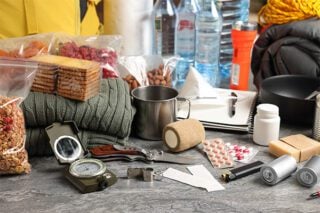
Natural disasters like hurricanes and blizzards disrupt people’s lives every year. But experts say planning can help keep people safe and allow communities to recover. Several organizations offer disaster planning resources for the public. These checklists and guides can help many people make effective plans, but what about cancer patients?
Cancer patients may have more to consider than most people when developing a natural disaster plan. They may need strategies for continuing their cancer care and staying in touch with doctors. So, natural disaster plans for cancer patients have two main parts. First, patients need a general disaster plan for themselves and their loved ones. Second, cancer patients need a cancer care disaster plan.
Making a General Natural Disaster Plan
Disaster planning starts with understanding potential risks. People need to research their homes and the areas around them to understand the dangers a disaster could create. Knowing about these risks ahead of time can help craft an effective disaster plan.
With these risks in mind, people can make a detailed disaster plan that covers:
- Emergency communications: Decide how you and your loved ones will stay in touch. This may include alternate communication methods like social media or checking in with an out-of-state contact.
- Evacuation or shelter-in-place options: Plan for evacuation and shelter-in-place situations. Make sure loved ones know what to do and where to go in either case.
- Natural disaster supplies: Build an emergency supply kit with water, food, cash and other life-sustaining supplies. This may include prescription medications, baby formula or corrective eyewear.
- Official documents: Gather important documents like deeds, leases and bank statements. Store them in a secure location like a fire-resistant and waterproof safe.
Natural Disaster Planning Resources
Accounting for Cancer and Treatment in a Natural Disaster Plan
Cancer patients may need several additional disaster plan components. So the first step is to allow plenty of prep time if at all possible. With that time, experts recommend the following:
- Discussing future treatments: Some cancer patients may have treatments scheduled during a forecasted natural disaster. The healthcare team can help patients make alternate treatment plans. This may include arranging some treatments at a cancer center outside of the potential disaster zone.
- Documenting medicines and treatment: Patients or caregivers should make a list of medicine names and dosages. They should also document any planned in-clinic treatments like chemotherapy or radiation. This can help ensure continuous care if healthcare infrastructure is disrupted.
- Having a healthcare communication plan: Patients should have a list of contact information for their doctors, clinics, hospitals and pharmacies. This list should include backup contacts in case a patient’s regular healthcare providers cannot be reached.
- Planning ahead for prescriptions: Cancer patients taking prescription drugs should discuss them with the oncology team. The team can help secure extra medication if necessary. Experts recommend patients keep their doses on schedule if possible.
- Staying safe in shelters: Some natural disasters may force cancer patients to evacuate to a community shelter. Experts recommend wearing a mask or face covering, washing or sanitizing hands often and drinking only bottled or boiled water. These steps can help protect cancer patients from germs. Patients should also learn how to get medical assistance in a shelter. This may help in the event of an illness or medical emergency.
The list above may seem overwhelming, but patients do not have to make these plans on their own. Doctors and other healthcare providers can help, as can loved ones and caregivers. Cancer patients can also reach out to the American Cancer Society at 1-800-227-2345.




